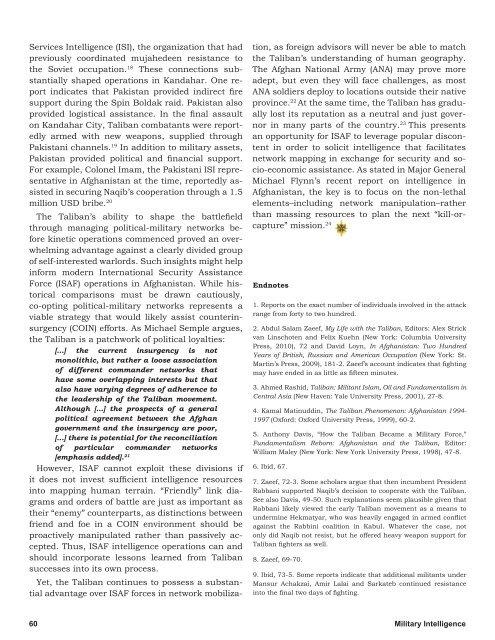George w. casey jr. - Federation of American Scientists
George w. casey jr. - Federation of American Scientists
George w. casey jr. - Federation of American Scientists
You also want an ePaper? Increase the reach of your titles
YUMPU automatically turns print PDFs into web optimized ePapers that Google loves.
Services Intelligence (ISI), the organization that had<br />
previously coordinated mujahedeen resistance to<br />
the Soviet occupation. 18 These connections substantially<br />
shaped operations in Kandahar. One report<br />
indicates that Pakistan provided indirect fire<br />
support during the Spin Boldak raid. Pakistan also<br />
provided logistical assistance. In the final assault<br />
on Kandahar City, Taliban combatants were reportedly<br />
armed with new weapons, supplied through<br />
Pakistani channels. 19 In addition to military assets,<br />
Pakistan provided political and financial support.<br />
For example, Colonel Imam, the Pakistani ISI representative<br />
in Afghanistan at the time, reportedly assisted<br />
in securing Naqib’s cooperation through a 1.5<br />
million USD bribe. 20<br />
The Taliban’s ability to shape the battlefield<br />
through managing political-military networks before<br />
kinetic operations commenced proved an overwhelming<br />
advantage against a clearly divided group<br />
<strong>of</strong> self-interested warlords. Such insights might help<br />
inform modern International Security Assistance<br />
Force (ISAF) operations in Afghanistan. While historical<br />
comparisons must be drawn cautiously,<br />
co-opting political-military networks represents a<br />
viable strategy that would likely assist counterinsurgency<br />
(COIN) efforts. As Michael Semple argues,<br />
the Taliban is a patchwork <strong>of</strong> political loyalties:<br />
[…] the current insurgency is not<br />
monolithic, but rather a loose association<br />
<strong>of</strong> different commander networks that<br />
have some overlapping interests but that<br />
also have varying degrees <strong>of</strong> adherence to<br />
the leadership <strong>of</strong> the Taliban movement.<br />
Although […] the prospects <strong>of</strong> a general<br />
political agreement between the Afghan<br />
government and the insurgency are poor,<br />
[…] there is potential for the reconciliation<br />
<strong>of</strong> particular commander networks<br />
[emphasis added]. 21<br />
However, ISAF cannot exploit these divisions if<br />
it does not invest sufficient intelligence resources<br />
into mapping human terrain. “Friendly” link diagrams<br />
and orders <strong>of</strong> battle are just as important as<br />
their “enemy” counterparts, as distinctions between<br />
friend and foe in a COIN environment should be<br />
proactively manipulated rather than passively accepted.<br />
Thus, ISAF intelligence operations can and<br />
should incorporate lessons learned from Taliban<br />
successes into its own process.<br />
Yet, the Taliban continues to possess a substantial<br />
advantage over ISAF forces in network mobilization,<br />
as foreign advisors will never be able to match<br />
the Taliban’s understanding <strong>of</strong> human geography.<br />
The Afghan National Army (ANA) may prove more<br />
adept, but even they will face challenges, as most<br />
ANA soldiers deploy to locations outside their native<br />
province. 22 At the same time, the Taliban has gradually<br />
lost its reputation as a neutral and just governor<br />
in many parts <strong>of</strong> the country. 23 This presents<br />
an opportunity for ISAF to leverage popular discontent<br />
in order to solicit intelligence that facilitates<br />
network mapping in exchange for security and socio-economic<br />
assistance. As stated in Major General<br />
Michael Flynn’s recent report on intelligence in<br />
Afghanistan, the key is to focus on the non-lethal<br />
elements–including network manipulation–rather<br />
than massing resources to plan the next “kill-orcapture”<br />
mission. 24<br />
Endnotes<br />
1. Reports on the exact number <strong>of</strong> individuals involved in the attack<br />
range from forty to two hundred.<br />
2. Abdul Salam Zaeef, My Life with the Taliban, Editors: Alex Strick<br />
van Linschoten and Felix Kuehn (New York: Columbia University<br />
Press, 2010), 72 and David Loyn, In Afghanistan: Two Hundred<br />
Years <strong>of</strong> British, Russian and <strong>American</strong> Occupation (New York: St.<br />
Martin’s Press, 2009), 181-2. Zaeef’s account indicates that fighting<br />
may have ended in as little as fifteen minutes.<br />
3. Ahmed Rashid, Taliban: Militant Islam, Oil and Fundamentalism in<br />
Central Asia (New Haven: Yale University Press, 2001), 27-8.<br />
4. Kamal Matinuddin, The Taliban Phenomenon: Afghanistan 1994-<br />
1997 (Oxford: Oxford University Press, 1999), 60-2.<br />
5. Anthony Davis, “How the Taliban Became a Military Force,”<br />
Fundamentalism Reborn: Afghanistan and the Taliban, Editor:<br />
William Maley (New York: New York University Press, 1998), 47-8.<br />
6. Ibid, 67.<br />
7. Zaeef, 72-3. Some scholars argue that then incumbent President<br />
Rabbani supported Naqib’s decision to cooperate with the Taliban.<br />
See also Davis, 49-50. Such explanations seem plausible given that<br />
Rabbani likely viewed the early Taliban movement as a means to<br />
undermine Hekmatyar, who was heavily engaged in armed conflict<br />
against the Rabbini coalition in Kabul. Whatever the case, not<br />
only did Naqib not resist, but he <strong>of</strong>fered heavy weapon support for<br />
Taliban fighters as well.<br />
8. Zaeef, 69-70.<br />
9. Ibid, 73-5. Some reports indicate that additional militants under<br />
Mansur Achakzai, Amir Lalai and Sarkateb continued resistance<br />
into the final two days <strong>of</strong> fighting.<br />
60 Military Intelligence















